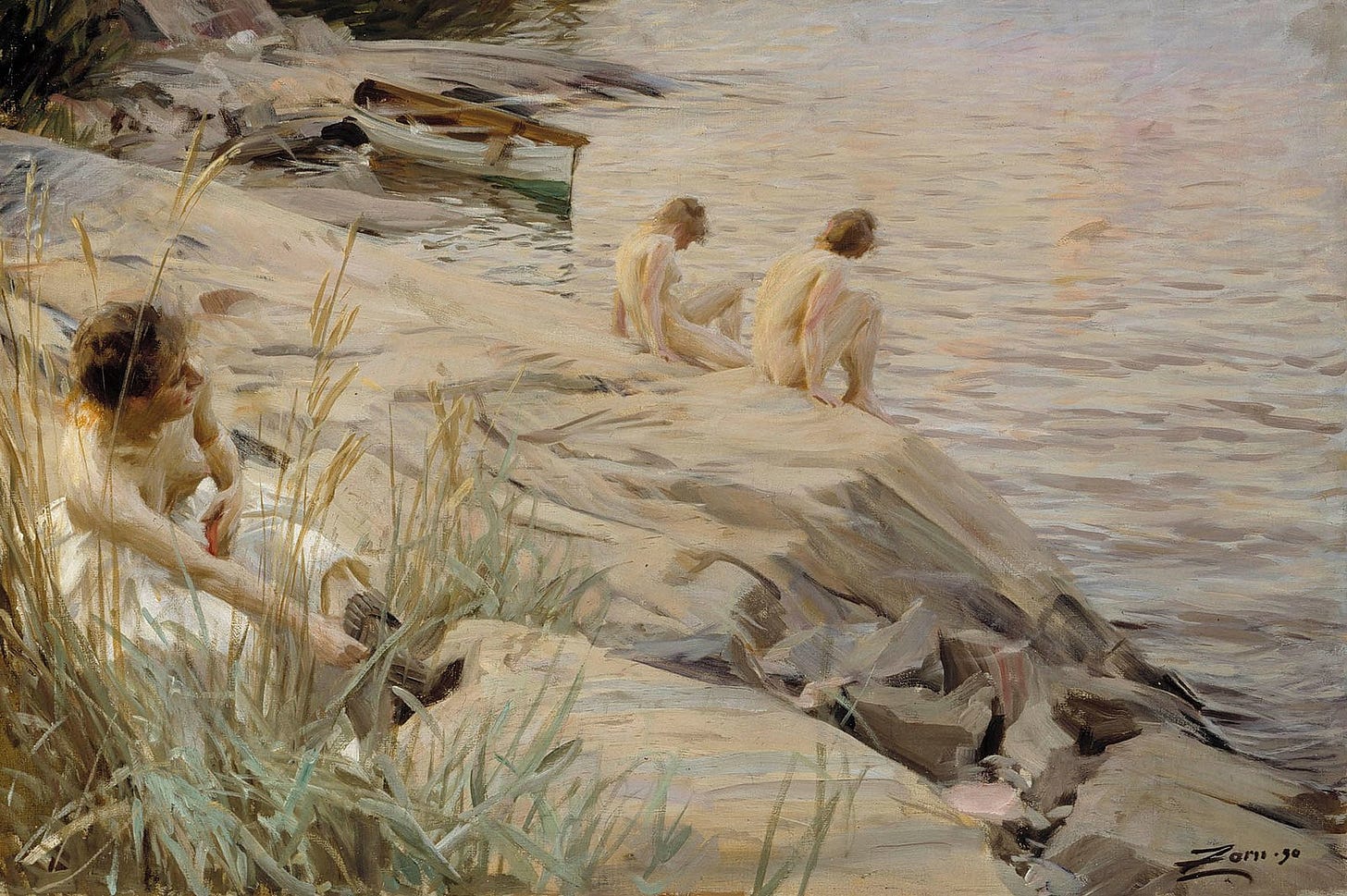Art: Realistic versus Abstract
At Home with the Glynns, Chapter 33:
“Okay, Peter,” said Martha. “Look at Our Father’s painting.”
She flipped the light switch, and for a moment the studio was illuminated, but only for a moment. She flipped the switch off again almost at once.
“Did you see it?” she asked.
“I think so,” I said. “Could you give me one more look?”
“No,” said Margot. “We’re sure to get caught.”
“Okay,” I said. “Just let me close my eyes for a minute and see if I’ve got it.”
[…] In the single moment of light Martha had allowed me, I had seen, painted across this map of canvas, stretched from one end to the other, two nude figures, the nearer one reclining, her head propped on her hand, and the one behind her leaning on her arm. They had been simplified into patterns of black and white, and rendered with broad swipes of the roller, but still they were obviously Margot and Martha.
Here is my attempt to give you an experience similar to Peter’s, beginning with the studio in darkness, then with the painting illuminated for only a moment, then with the return to darkness:
Did you notice that the painting was actually a mosaic of smaller canvases slightly separated from one another?
To create this simulation, I had to do some violence to Anders Zorn’s “Girls Bathing in Open Air.” Here is the original, from Wikimedia:
The girls are not posed as Peter describes them, obviously. I couldn’t find anything online that exactly matched the description. I cropped the Zorn painting so that there are only two girls, representing Margot and Martha. I converted the image to grayscale, since Andrew Glynn worked primarily in “charcoal gray.” The girls’ hair became too dark. They should be blondes.
Art: Painting: From Life versus From Memory
At Home with the Glynns, Chapter 33:
“People think Our Father’s paintings are pure abstractions, but they’re not.”
“Oh?”
“No,” said Margot. “You see, he just can’t seem to shed the crutch of realism, so this is his way of hiding his dependence.” […]
“Do you pose for him?” I asked.
“No,” said Martha. “Well, sort of. He tells us how he wants us arranged, we take our positions, and he looks at us for a minute. That’s it. He does the painting from memory, so it’s more what he thinks we look like than what we really do.”
Edgar Degas to Georges Jeanniot, quoted by Otto Friedrich in Olympia: Paris in the Age of Manet:
It is very good to copy what one sees; it is much better to draw what you can’t see any more but in your memory. It is a transformation in which imagination and memory work together.
You only reproduce what struck you, that is to say the necessary.
That way, your memories and your fantasy are freed from the tyranny of nature.
See also:
Art, Play TG 5; Paint-by-Numbers TG 107, TG 108; Necessity of Transformation in TG 110; Doodling TG 165; Art Materials: Masonite TG 167; Art and Craft and Real Life TG 385; Art: Literature: Responding to: Sharing the Experience TG 367, TG 617; Conceptual TG 482; Commodification of TG 482; The Reciprocal Relationship Between the Artist and the Work TG 742; Painting: Rollers as Tools for TG 817; Subjects: Animals: Clams TG 818; Abstraction TG 824
Have you missed an episode or two or several?
You can begin reading at the beginning or you can catch up by visiting the archive or consulting the index to the Topical Guide. The Substack serialization of Little Follies begins here; Herb ’n’ Lorna begins here; Reservations Recommended begins here; Where Do You Stop? begins here; What a Piece of Work I Am begins here; At Home with the Glynns begins here.
You can listen to the episodes on the Personal History podcast. Begin at the beginning or scroll through the episodes to find what you’ve missed. The Substack podcast reading of Little Follies begins here; Herb ’n’ Lorna begins here; Reservations Recommended begins here; Where Do You Stop? begins here; What a Piece of Work I Am begins here; At Home with the Glynns begins here.
You can listen to “My Mother Takes a Tumble” and “Do Clams Bite?” complete and uninterrupted as audiobooks through YouTube.
You can ensure that you never miss a future issue by getting a free subscription. (You can help support the work by choosing a paid subscription instead.)
At Apple Books you can download free eBooks of Little Follies, Herb ’n’ Lorna, Reservations Recommended, and Where Do You Stop? and What a Piece of Work I Am.
You’ll find overviews of the entire work in An Introduction to The Personal History, Adventures, Experiences & Observations of Peter Leroy (a pdf document), The Origin Story (here on substack), Between the Lines (a video, here on Substack), and at Encyclopedia.com.



